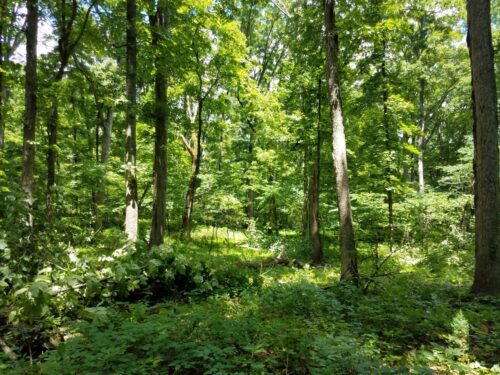Field Notes: Shedding Light on the Situation
July 20, 2018 11:39 am

by Area Forester Sarah Long
If you were out in the Conway Robinson State Forest around the end of June, you might have wondered what those folks with chainsaws were doing to your state forest. As one of those folks with a chainsaw, I am here to tell you that tale.
Trees produce untold pounds and pounds of seed every year in the hope that just a few of them land in a place they can grow into seedlings. Of those seedlings, even fewer will make it to the canopy to replace their parents. Seedlings need three basic things to live; sunlight, nutrients, and water. Of these three, the one we are most able to influence in a forest setting is sunlight. Whether they make it the canopy or not largely depends on the availability of light during their early development. This is where the chainsaws come in.
In a mature forest, there will be canopy trees in the sky and seedlings on the ground. In between there is a layer of mid-story trees. Some of them are shade tolerant trees like flowering dogwood and redbud which will never grow into the canopy, but will spend their lives in the shade of taller trees. Others are the same species as the trees in the canopy, but due circumstances have been outgrown by their neighbors and so remain stunted in the mid-story. These trees often look small but are in fact as old as the larger trees, which is why you cannot guess how old a tree is based on size. Because they are old and stunted or simply not genetically predisposed, these mid-story trees will not be able to replace the canopy trees even if all the canopy trees are removed.

Conway Robinson State Forest before mid-story removal; very little sunlight is reaching the forest floor
There are many species of oak in the forest. The oak family makes up the backbone of our hardwood forests in Virginia now that we no longer have the American chestnut. Not only are they physically significant on the landscape, but they are also an important food source for our forest critters and an important pollen source for pollinators. However, they can be very difficult to regenerate. Regeneration is how the forest replaces itself with or without a harvest. That is also why we decided to perform a “mid-story removal” on patches of our forest. Mid-story removal is pre-commercial which means that we will not generate any income from this practice. But, what we hope we achieved is a little more sunlight getting to our seedlings, especially our oaks.
Some seedlings like full sunlight. These are species like black locust, eastern juniper, and most members of the pine family. These trees tend to grow quickly, but do not live as long as slower growing species. Oak seedlings play the long game by putting resources into their roots and growing slowly and steadily. They need filtered sunlight because it will disadvantage faster growing trees that would otherwise over-top them and smother them with shade.

Conway Robinson State Forest after mid-story removal; more sunlight is available to seedlings
Our goal in removing some mid-story trees, but no canopy trees is to give our crop of oak seedlings the filtered sunlight they need to grow to above head-height (6-10 feet tall). At this height they are above the browse line of deer and poised to move up in the world. If we achieve this we will have a forest that can regenerate the existing oak canopy. This would ensure that the forest would still be oak dominant if we were to conduct a timber harvest or experience a natural disaster that wiped out our bigger trees. That is our long-term goal, but we’ll have to see what Mother Nature has to say about it. Stay tuned.
Tags: Hardwood
Category: Forest Management, State Forests
